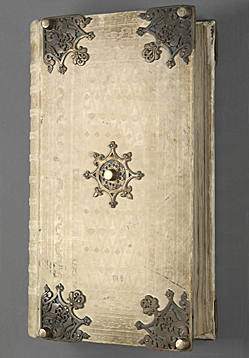Probably not, but it makes a great story. Once considered the eighth wonder of the world, the Codex Gigas (“Giant Book”) is the largest medieval manuscript in existence and is known as the Devil’s Bible because it contains a large illustration of the devil and because of the legend surrounding the manuscript’s creation: “There is a legend concerning the making of the Codex Gigas that relates that it was the work of one scribe, and that the task was so enormous it was completed with the help of the devil. The origin of the legend is unknown, and although it is clearly without any basis in truth, it shows how the enormous size of the manuscript so impressed those who saw it that it was attributed a supernatural origin” (source). In accordance with its historical mission “to increase and diffuse geographic knowledge while promoting the conservation of the world’s cultural, historical, and natural resources,” National Geographic has featured the Codex Gigas on TV and the internet as part of its “Mysteries of the Bible” video series – see “The Truth Behind the Devil’s Bible (no longer displayed from the National Geographic website).”
The 310 existing parchment leaves (620 pages; some are missing) of the Codex Gigas are made of vellum, using the processed skins of an estimated 160 donkeys or calves. The text is in Latin, and the manuscript is lavishly illuminated throughout. Lexicologists believe that the work actually was created by one person, but over a period of approximately 20 years (not, as legend would have it, in one night with the help of the devil). Including its wooden case, which is ornamented with metal, the Codex Gigas weighs about 165 pounds and its pages measure 35 inches tall by 19 inches wide.
“The Codex Gigas contains five long texts as well as a complete Bible. The manuscript begins with the Old Testament, and it is followed by two historical works by Flavius Josephus who lived in the first century AD. These are The Antiquities and The Jewish War. After Josephus is the most popular Encyclopaedia of the middle ages, by Isidore, who lived in the sixth century in Spain. This is followed by a collection of medical works, and these are followed by the New Testament. The last of the long works is a Chronicle of Bohemia by Cosmas from Prague (ca 1045-1125). This is the first history of Bohemia and is an important work. There are also some short texts in the manuscript. The first, before the picture of the Heavenly City, is a work on penitence. The second, after the Devil portrait, is on exorcising evil spirits. The last important short work is a Calendar, containing a list of saints and local Bohemian persons on the days on which they were commemorated. There is also one lost work, on leaves that have been cut out of the manuscript, the Rule of St Benedict, the essential guide to monastic life written in the sixth century” (source).
“The origin of the Codex Gigas is unknown. A note written in the manuscript states that it was pawned in the monastery at Sedlec by its owners, the monks of Podlažice, in 1295 (f. 1v). It soon passed to the monastery of Břevnov near Prague. All of these monasteries were in Bohemia (now in the modern Czech Republic), and it is certain that the Codex Gigas was made somewhere in Bohemia, but not necessarily at Podlažice, a small and unimportant monastery. In 1594 Rudolf II removed the Codex Gigas to his castle in Prague where it remained until it was taken during the Thirty Years War, with many other treasures, by the army of Sweden to Stockholm. It then entered the collection of Queen Christina of Sweden and was put into the royal library in the castle at Stockholm. There it remained until 1877 when it entered the newly built National Library of Sweden in Stockholm” (Ibid.). The Codex Gigas went back to Prague for the first time in 350 years, on loan, in 2008 and was returned to Sweden the following year.
“The provenance of this extraordinary book and its unlikely story as well as its journey across centuries, passing through a succession of monasteries and royal palaces to its current destination, the National Library of Sweden, is a legitimate story for National Geographic to cover. And it makes good television too”.
Editor’s note: The Official Codex Gigas site of the National Library of Sweden contains a digitized version of every page of the manuscript as well as commentaries on its history, texts, script, initials, and decoration. The original manuscript is kept in a climate controlled store room and is not on display for the general public.
Article by Bill Norrington




